The reconstructed town has many buildings, some famous, like the govenors palace (not shown here) or the capitol building, shown here:

I especially loved the windows and that is why the picture is included in this post. This building was the heart of the government. Trials occurred here, delegates met to discuss, much as our government representatives do today, about the mundane issues of keeping a government afloat. However there was one special issue during this period, that of the declaration of independence from the mother country. As the guide walked us through the building and talked of how it all happened, it made history come alive, just like reading a historical novel.
Most of the building though are the common shops and houses. As you stroll along the street many of these are open and available to the public, like the silversmith's house, shown below.

Did you know that in those days you could take a silver spoon to pay for an item? They would snip off and weigh the silver based on the current price. As for your poor mutilated spoon, well you could take that to the silversmith and have him recreate a new one for you, although it would probably be the smaller sized salt spoon.
Being in the medical profession, my favorite building was the apothecary. This was run by a doctor and his assistant. When you walked through the door, this is what you would see:

These bottles and jars are not original to Williamsburg itself, but are from England at the exact same period of time. They were in fantastic shape for over 200 years old! When you were ill, you went to see the doctor at the apothecary. He had his office behind the storefront, and would decide what you needed to buy to make you better. You of course had brought your own bottle and jar for whatever ointment, tincture, herb, or other exotic types of medicines of the day. If for some reason you had to have the doctor come to your house, the bill would include not only the housecall fee and medicines, but also a price per mile he had to travel. The thought was if he had to close up his business just to go see you, you had to pay for that loss of income! So the era of the friendly housecalling doctor was much yet to come.
Several of the homes were open for touring, a nice look into the daily life of the colonials. Just to get this post back to the fiber theme, here is a picture of a lady's dressing table:

Those are hand embroidered kid gloves, and very lovely indeed.
Most larger households had what they called a 'working yard'. The mistress of the house was in charge of all of this. The out buildings may include kitchens, smoke houses, gardens, orchards, blacksmith and stables. In one working yard, we were able to visit the weavers place.
Here's what you'd see as you walk into the door:
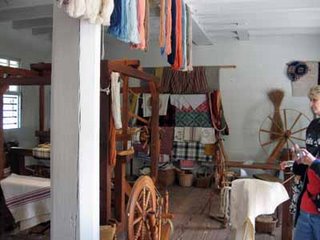
There was a weaver working at a large loom, making a bed rug. She was very willing to talk about her daily work and I learned some interesting facts. First of all, even though there were many spinning wheels there, she said that these colonials were actually wealthy by that day's standards, due to the sale of tobacco. And so just like us today, when we need a large amount of yarn for weaving, they _bought_ their yarn! But another interesting historical fiber tidbit is that when the weather was rainy and the slaves could not work in the field, many would spend time carding and spinning yarn, which was theirs to keep.
The weaver said that the yarn hanging above her loom was from a longwool breed, natural dyed. I felt some and it did have a rough hand to it. However, she showed me a woven piece requested by the mistress that was made in a very soft wool, so they must have had some shorter softer staple wool available.
Here's a picture of the yarn:
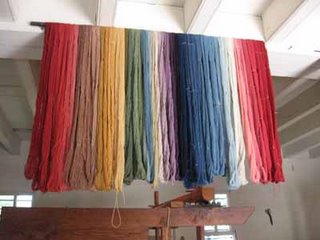
There was a great wheel there of course:

But look at this next picture closely, I found this much more interesting than the great wheel. It is a quill wheel, and I had never seen one before.
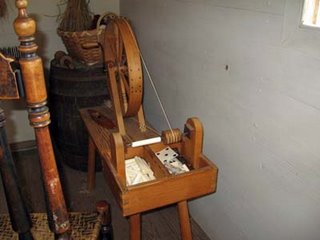
If you look you can see what looks like a playing card, and that is exactly what it is, I saw a deck of cards for sale in the printer shop. They were using them to make quills for the great wheels bobbin. I know corn husks are more traditional, but this was an urban area! Or maybe it's just an interesting past time, to amuse a child while the mother spun on the wheel.
This photo comes under the 'I find that hard to believe' category, but I think I have the story straight from the weaver. It is a small replica version of an actual bed rug from the colonial period of time. Rugs were not put on the floor, but were used on beds for warmth. I can believe that part. What I find hard to believe is that that design is truly of the period, look how 1970's it looks!
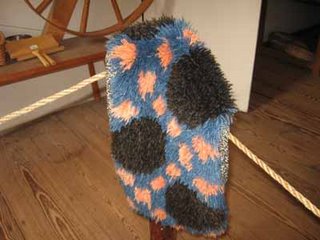
When I finally left the weaver's place I strolled around the rest of the working yard. There was a lovely dovecote, as well as gardens with fall crops still in great production. Under a tent, two basket makers were showing how the wood was thinly shaved and used to weave all styles of baskets. My favorite was a tiny one hanging from the tent pole, that contained suet for the birds.
Here's how they used twigs in part of the chicken coop:
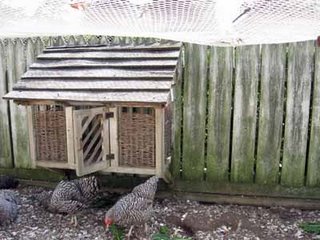
Very different from our modern day chicken coops. However, somethings don't change and here's a photo of the rabbit hutch to prove it:
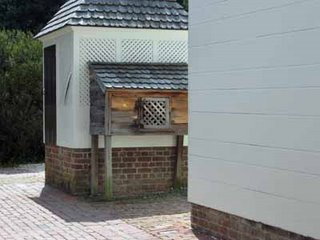
These are just a few of the hundreds of photos I took while there. Digital cameras are wonderful when traveling. Each evening I went back to where we stayed, downloaded the photos to the laptop, and sorted and labelled them while it was all fresh in my mind. So different than the albums of photos I have from my vacations in the 80's! Just where was that place in that photo? Ah, the wonders of technology arrived just in my time of failing memory!
Next post: Jamestown
CW
2 comments:
Wonderful pictures of the trip Cindy! I loved hearing your account of the different areas. Everything looks like it is in top shape too. That quill wheel is beautiful! I've never seen one except in photos...but as for the bed rug..well..it DOES look rather like those old "shag rugs" that were so popular! Loved the chicken coop~~and the silver spoon info was great too...looking forward to seeing Jamestown next!
Willliamsburg is one of my family's favorite yearly treks! Great pictures! I wonder if the old coin silver spoons are the spoons that you speak of?
Post a Comment